ASUS F1A75-M Pro Review - Micro-ATX Llano at $110
by Brendan van Varik on January 22, 2012 2:00 AM EST- Posted in
- Motherboards
- Asus
- Llano
USB Speed
For this benchmark, we run CrystalDiskMark to determine the ideal sequential read and write speeds for the USB port using our 64GB Patriot SuperSpeed USB 3.0 drive. Then we transfer a set size of files from the SSD to the USB drive, and monitor the time taken to transfer. The files transferred are a 1.52 GB set of 2867 files across 320 folders – 95% of these files are small typical website files, and the rest (90% of the size) are the videos used in the Sorenson Squeeze test.
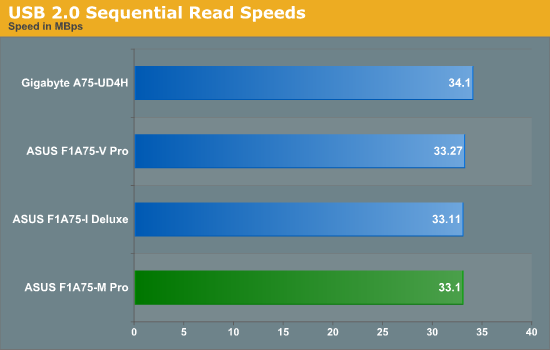
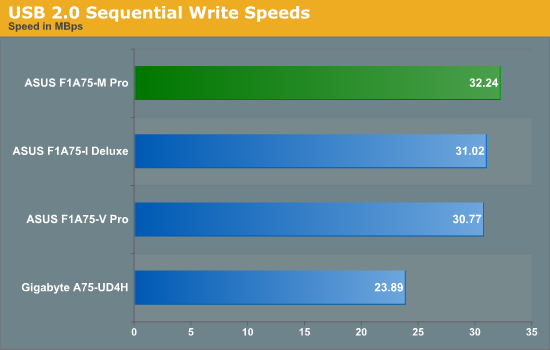

USB 2.0 performance is in the top half of our A75 testing.
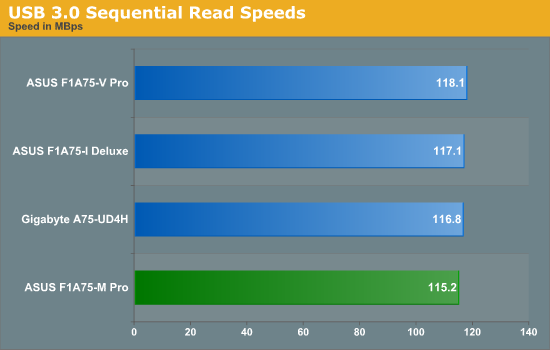
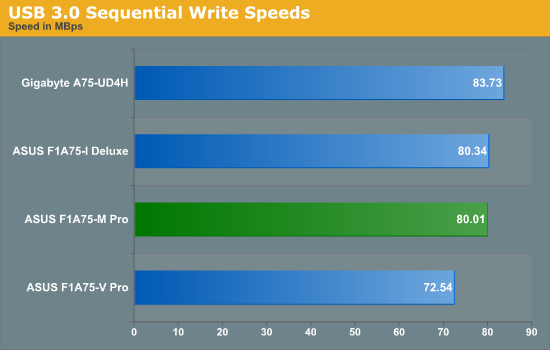
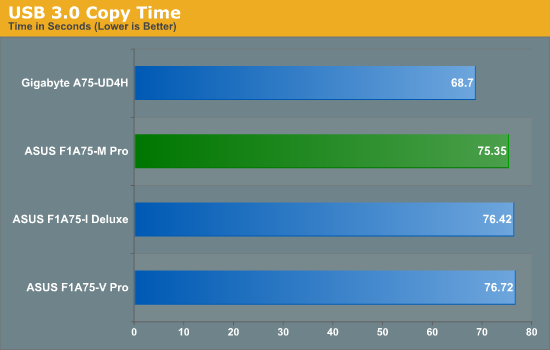
USB 3.0 is also good, but all the ASUS boards using default USB 3.0 drivers are some 7+ seconds behind the Gigabyte A75-UD4H.
SATA Testing
We also use CrystalDiskMark for SATA port testing. The operating system is installed on the SSD, and the sequential test is run at the 5 x 1000 MB level. This test probes the efficiency of the data delivery system between the chipset and the drive, or in the case of additional SATA ports provided by a third party controller, the efficiency between the controller, the chipset and the drive.
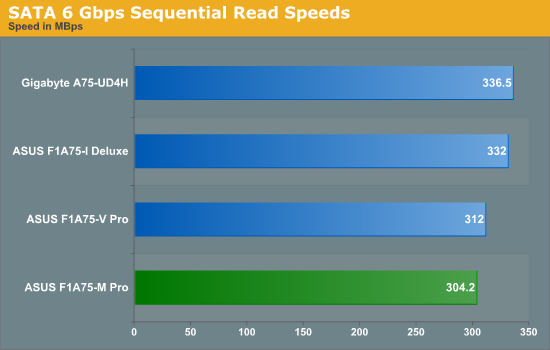
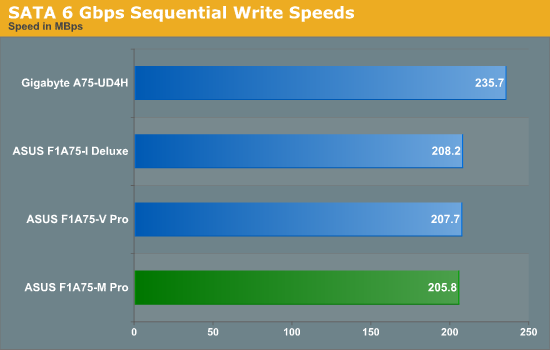
Unfortunately, there seems to be some limitation with ASUS boards in write speeds of SATA 6 Gbps compared to our other non-ASUS board tested.
DPC Latency
Deferred Procedure Call latency is a way in which Windows handles interrupt servicing. In order to wait for a processor to acknowledge the request, the system will queue all interrupt requests by priority. Critical interrupts will be handled as soon as possible, whereas lesser priority requests, such as audio, will be further down the line. So if the audio device requires data, it will have to wait until the request is processed before the buffer is filled. If the device drivers of higher priority components in a system are poorly implemented, this can cause delays in request scheduling and process time, resulting in an empty audio buffer – this leads to characteristic audible pauses, pops and clicks. Having a bigger buffer and correctly implemented system drivers obviously helps in this regard. The DPC latency checker measures how much time is processing DPCs from driver invocation – the lower the value will result in better audio transfer at smaller buffer sizes. Results are measured in microseconds and taken as the peak latency while cycling through a series of short HD videos - under 500 microseconds usually gets the green light, but the lower the better.
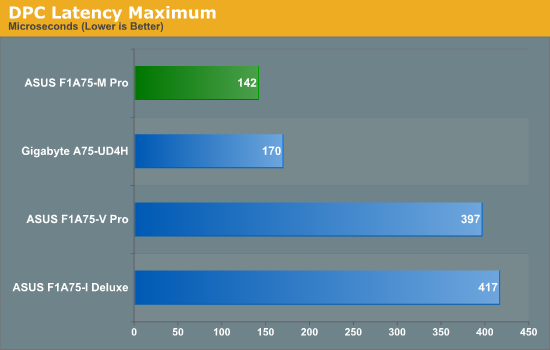
DPC Latency (once AI Suite II is turned off) is very amenable compared to other A75 boards.










32 Comments
View All Comments
cjs150 - Monday, January 23, 2012 - link
I have found Anandtechs reviews of the IGP to be very helpful, and I agree for boards which could be for an HTPC it would be a good idea to at least link back to the original IGP review.I cannot remember seeing a detailed review of on-board sound from Anand - other than whether it could be channeled through the HDMI port. Great suggestion - ANAND time to pick up on this one.
Whilst there is no need for U-ATX board for an HTPC build I keep looking at a Wesena case and thinking it could look very good
Also ANAND any chance of a review of the Pico-ITX announced by both Zotac and VIA, bit worried about the fans in them, but they could be a really stunning mini-HTPC (although would need to use USB for TV card which is not ideal) also maybe the Zotac AD04 announced at CES
geniekid - Monday, January 23, 2012 - link
FWIW, I use one of these in my HTPC and I haven't had any problems so far.ASUSTechMKT - Monday, January 23, 2012 - link
Kudos and glad to read everything has been smooth!edward2 - Monday, January 23, 2012 - link
PLEASE everyone who wants to buy this MB read this carefully!I bought an Asus F1A75-V Pro MB, before that I've read a lot of review about it and even the asus website specification etc. None of these were mentioning the following:
****These ASUS MBs are not supporting HDMI and DVI-D simultaneous use****
So the whole FM1 platform is completely useless for an HTPC and for a normal setup like HDTV + DVI monitor.
Death666Angel - Monday, January 23, 2012 - link
Then you didn't read very carefully:http://www.asus.com/Motherboards/AMD_Socket_FM1/F1...
"Note *1: HDMI and DVI-D cannot work simultaneously."
I don't really see how this affects the standard HTPC environment though, as I only know people with one TV in their living room. But if you do need that, you have to look elsewhere. :-)
ASUSTechMKT - Monday, January 23, 2012 - link
you can run HDMI/DVI out as the same time as VGA but dual digital output is not supported.Should you want this functionality you can enabled the multi display option within the UEFI and add an additional GPU like a 6500 or 6600 series GPU and then have dual digital output support.
As the user additionally notes this is listed on our support page.
ASUSTechMKT - Monday, January 23, 2012 - link
That is great thanks for the support and glad to read you have had a smooth and solid experience. Do not forgot to check out USB3 Boost which should be posted to your support site shortly or download it from our USB3 Boost landing page directly.rodrigo.dk - Monday, January 23, 2012 - link
I bought one of these in december, and WakeOnLan didn't worked at all. With recent updates it is working ;)D3xx - Monday, January 23, 2012 - link
How would this board and chip compare with an i5 2500 in Z68? Assume both are using 5850 graphics.fluxtatic - Tuesday, January 24, 2012 - link
Are you trolling?On topic, I've got to agree with some of the above - if the graph was labeled correctly, how are you going to publish power consumption numbers on a Llano board with 2 5850s (and then call it typical)? Especially given that half the appeal of Llano is that you don't need discrete graphics at all in most cases?
I can see 1 discrete card for the HTPC market, but likely a low-noise model - lower-end mainstream with either a massive, slow fan, or a colossal heat sink and no fan at all.